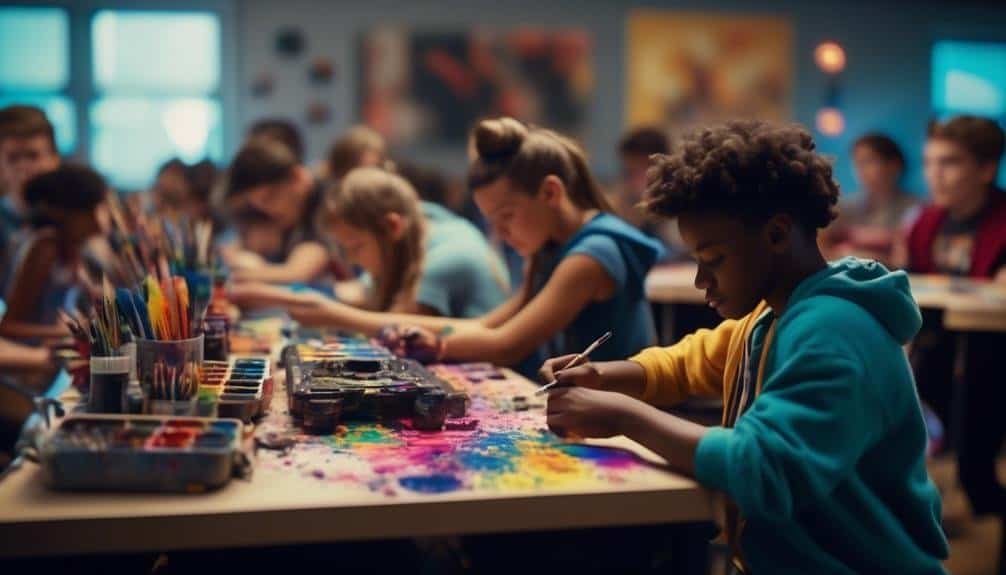Fostering Creativity in Learning Environments
Are you tired of the same old, boring learning environments that stifle creativity and leave students feeling uninspired? Well, get ready to discover the secrets of fostering creativity in education.
In this discussion, we will explore the importance of creativity in learning, the essential elements of a nurturing environment, and strategies to cultivate innovation and critical thinking.
By the end, you'll be equipped with practical ideas to transform your classroom into a hub of imagination and inspiration. So, let's dive in and unlock the potential of creativity in education!
Key Takeaways
- Creativity in education empowers students to think critically, problem-solve, and develop innovative solutions.
- Creating a nurturing learning environment involves encouraging self-expression, embracing diversity, providing autonomy, and establishing a supportive and inclusive atmosphere.
- Encouraging critical thinking and problem-solving includes challenging traditional ways of thinking, developing innovative solutions, fostering a culture of creativity, and creating a supportive environment that values and rewards creative thinking.
- Fostering creativity in learning environments requires thinking outside the box, developing the ability to find unconventional approaches, encouraging brainstorming and exploration of unconventional ideas, and creating a supportive environment that values and rewards creative thinking.
The Importance of Creativity in Education
Creativity is an essential component of education as it empowers students to think critically, problem-solve, and develop innovative solutions. The role of imagination in education can't be underestimated. By encouraging students to tap into their imagination, schools promote artistic expression and provide a platform for students to explore their creativity.
Artistic expression in schools plays a crucial role in fostering creativity. Through art classes, students are encouraged to think outside the box, experiment with different mediums, and express their unique perspectives. This not only allows them to develop their artistic skills but also nurtures their ability to think creatively and solve problems in unconventional ways.
Furthermore, promoting artistic expression in schools has a multitude of benefits. It enhances student engagement and motivation, as students are given the opportunity to pursue their passions and express themselves through various art forms. It also fosters a sense of self-confidence and self-expression, as students learn to communicate their ideas and emotions through their artwork.
Incorporating imagination and artistic expression into education is essential for preparing students for the future. In a rapidly changing world, where innovation and problem-solving are highly valued, creativity is a skill that can't be overlooked. By embracing creativity in education, schools empower students to become critical thinkers and innovative problem solvers, ensuring their success in an ever-evolving society.
Creating a Nurturing Learning Environment
To create a nurturing learning environment, it's crucial to establish a supportive and inclusive atmosphere where every student feels valued and encouraged to explore their potential. Here are three key elements that can help foster creativity and imagination in the classroom:
- Encouraging self-expression: Provide opportunities for students to share their thoughts, ideas, and opinions without fear of judgment. This can be done through class discussions, group projects, or creative assignments that allow students to showcase their unique perspectives.
- Embracing diversity: Create a space that celebrates and embraces diversity in all its forms. Encourage students to appreciate different cultures, backgrounds, and experiences. This not only fosters a sense of belonging but also exposes students to different ways of thinking and problem-solving.
- Providing autonomy: Give students the freedom to explore their interests and passions. Allow them to choose topics for research projects or provide options for creative assignments. This autonomy empowers students to take ownership of their learning and encourages them to think outside the box.
Encouraging Critical Thinking and Problem Solving
To encourage critical thinking and problem solving, it's important to encourage students to think outside the box and approach problems from different perspectives.
By challenging traditional ways of thinking and encouraging creativity, students can develop innovative solutions to real-world problems.
This fosters a sense of autonomy and empowers students to become confident problem solvers.
Think Outside the Box
Encourage critical thinking and problem solving by challenging students to explore innovative solutions beyond traditional approaches.
In today's rapidly changing world, it's crucial for students to develop the ability to think outside the box and find unconventional approaches to complex problems. By fostering a culture of creativity and encouraging students to question established norms, educators can cultivate a mindset that embraces innovation and unconventional thinking.
Here are three strategies to help students think outside the box:
- Encourage brainstorming sessions that allow for the exploration of unconventional ideas.
- Provide open-ended assignments that require students to find innovative solutions.
- Foster a supportive environment that values and rewards creative thinking.
Solving Real-World Problems
Develop critical thinking and problem-solving skills by challenging students to apply their knowledge and creativity to solve real-world problems. By engaging students in this way, they're encouraged to think critically and come up with innovative solutions that have practical applications.
Solving real-world problems helps students see the relevance and importance of their learning, as they're able to apply their knowledge to tangible situations. This approach also fosters creativity, as students are encouraged to think outside the box and come up with unique solutions to complex problems.
Inspiring Innovation and Idea Generation
By creating a dynamic and stimulating learning environment, you can ignite the spark of innovation and foster the generation of new ideas. Here are three key strategies to inspire innovation and idea generation in your learning environment:
- Encourage curiosity: Curiosity is the fuel for innovation. Encourage students to question, explore, and seek answers to their own inquiries. Provide opportunities for independent research and experimentation, allowing students to follow their interests and uncover new possibilities.
- Foster imagination: Imagination is the gateway to creativity. Create a space that stimulates imagination through visual aids, interactive tools, and open-ended projects. Encourage students to think outside the box, embrace unconventional ideas, and challenge existing norms. Encourage them to visualize their ideas and bring them to life through various mediums such as art, writing, or technology.
- Promote collaboration: Collaboration breeds innovation. Foster a collaborative learning environment where students can exchange ideas, share perspectives, and work together towards common goals. Encourage group discussions, brainstorming sessions, and project-based learning activities. By working together, students can leverage their diverse skills and insights to generate innovative solutions.
Embracing Diversity and Individuality
To create an inclusive and empowering learning environment, it's essential to embrace the diversity and individuality of every student. Celebrating uniqueness and promoting inclusion are key components of fostering creativity in educational settings.
By embracing diversity, you create a rich tapestry of perspectives and experiences in the classroom. This allows for the exploration of different ideas, leading to more innovative and creative solutions. Each student brings a unique set of skills, talents, and backgrounds, which can be harnessed to create a dynamic learning environment.
Promoting inclusion is equally important. It ensures that every student feels valued and respected, regardless of their race, gender, ethnicity, or socio-economic background. When students feel included, they're more likely to share their ideas and take risks, which can lead to breakthroughs and new discoveries.
To embrace diversity and individuality, it's important to create a safe and supportive environment where students feel comfortable expressing themselves. Encourage open dialogue, active listening, and empathy among students. Provide opportunities for collaborative projects and group discussions, where different perspectives can be shared and appreciated.
Strategies for Cultivating Creativity in the Classroom
What strategies can you implement to cultivate creativity in your classroom?
To foster creativity in your classroom and engage students in meaningful ways, consider incorporating project-based learning. This approach encourages students to explore real-world problems and find innovative solutions.
Here are three strategies to cultivate creativity in your classroom:
- Encourage open-ended projects: Provide students with opportunities to work on projects that allow for multiple solutions and interpretations. This freedom allows them to think critically, solve problems creatively, and express their unique ideas.
- Foster collaboration: Create a collaborative learning environment where students can work together on projects. Collaborative projects encourage students to share and build upon each other's ideas, fostering creativity through collective thinking.
- Provide choice and autonomy: Offer students choices in their learning, allowing them to pursue topics and projects that align with their interests. By giving them autonomy, you empower them to take ownership of their learning and unleash their creative potential.
Conclusion
As you step back from the canvas of education, brush in hand, you witness the masterpiece of creativity that has been cultivated.
The vibrant strokes of critical thinking and problem solving blend seamlessly with the bold splashes of innovation and idea generation.
The tapestry of diversity and individuality weaves a rich and textured fabric.
Through nurturing learning environments and strategic cultivation of creativity, the classroom becomes a sanctuary where brilliance blossoms and the possibilities are endless.







